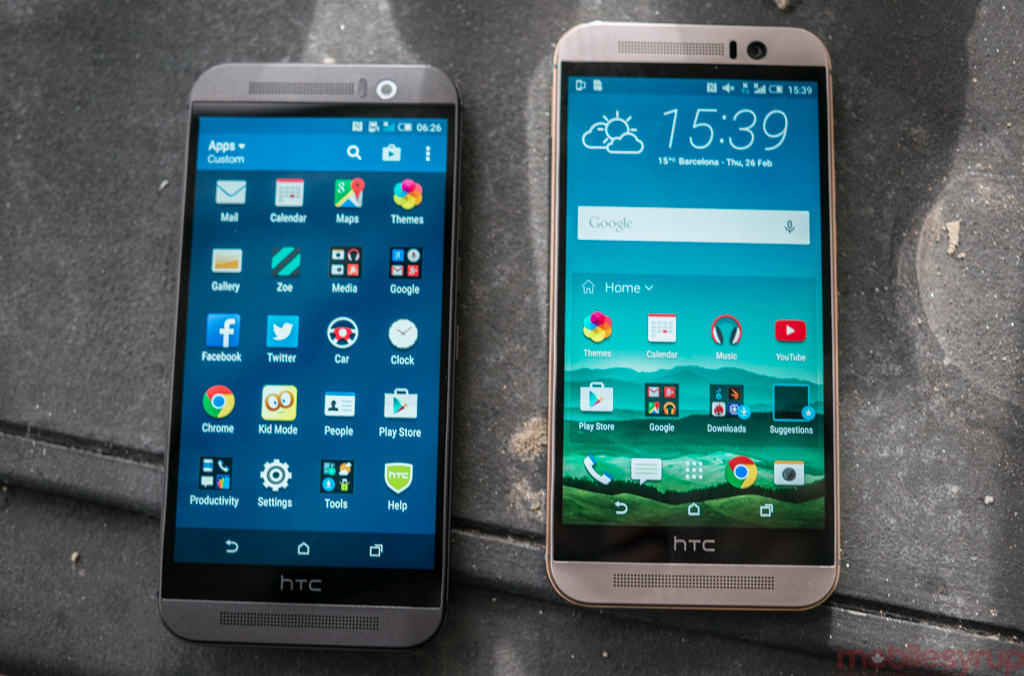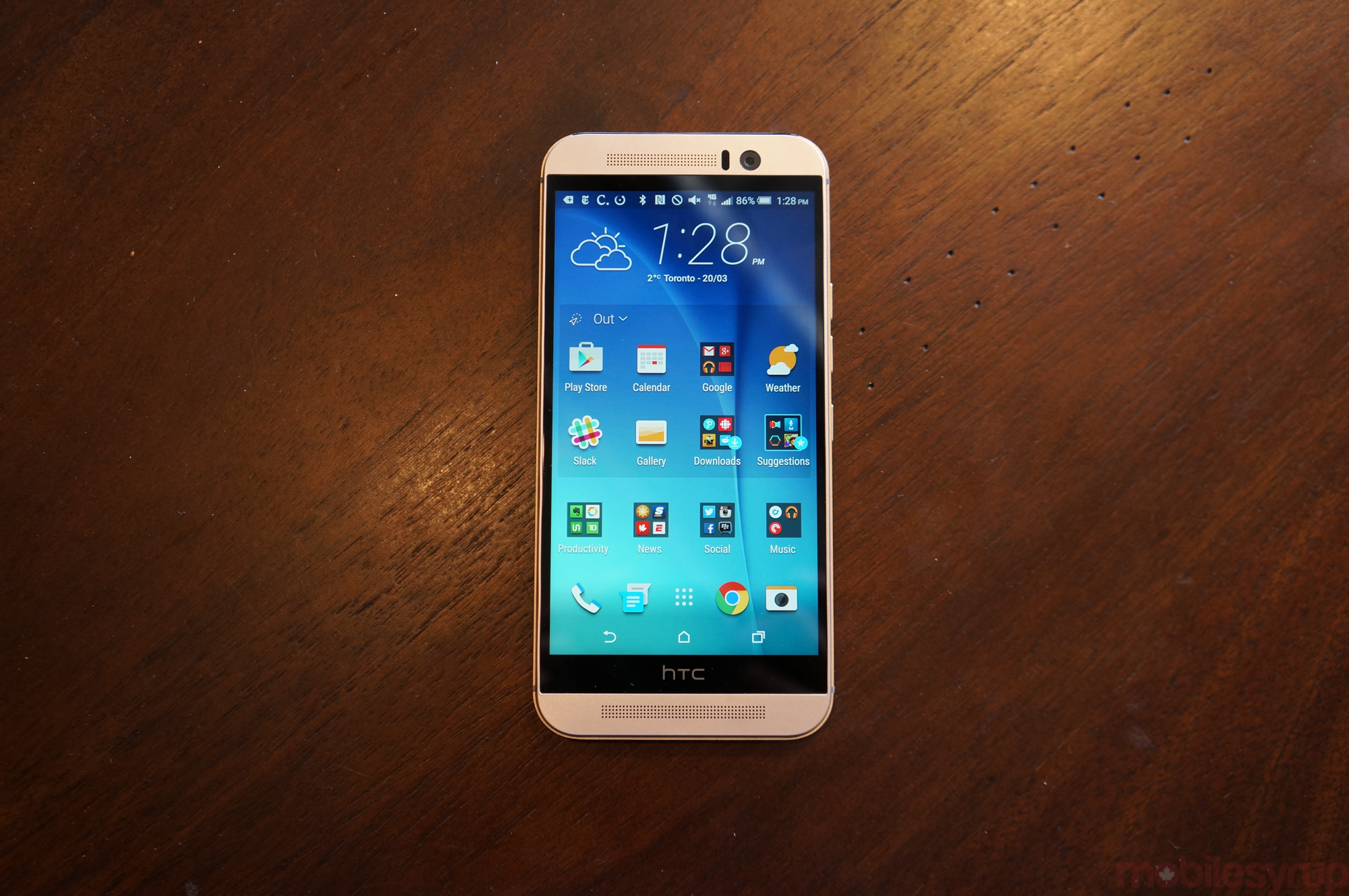
There are few more distinctive Android phones on the market than the HTC One line. The company that experimented with unibody metal when most smartphones were plastic, HTC’s critical acclaim is increasingly at odds with its commercial success — or lack thereof. They barely squeaked a profit last quarter, though it was the first time it spilled black ink in over a year, so with the One M9 it hopes to continue that ambling turnaround with a phone that is both a critical and commercial hit.
Pros
- Beautiful, two-tone metal finish
- Substantial performance improvements over M8
- 20MP camera can capture some great photos
- UltraPixel selfie cam performs well in low-light
- High sound quality
- Excellent battery life
- Sense 7 feels lightweight and free of bloatware
Cons
- Disappointing low-light camera performance
- Lack of optical image stabilization
- Device can get very warm under load
Unlike Samsung or Apple’s latest smartphones, which comprise the “tock” in a tick-tock cycle, the HTC One M9 is clearly an iterative upgrade over the still-excellent M8. In fact, the device looks like a hybrid of the past two versions, with HTC resurrecting the grippier edges of the M7 while improving the brushed metal anodizing of the M8.
Despite its aging design, the phone is still beautiful, its distinctiveness a product of tasteful considerations honed over time. The body, a single block of machined aluminum, has a two-toned finish, with the secondary gold hue surrounding the uniform brushed metal of the base. The flagship colour, a combination of lighter silver and rose gold, is luxurious and expensive-feeling, an impression furthered by the heftiness of the device itself.
Specs
- Android 5.0.2 w/ Sense 7.0
- 5-inch 1920×1080 pixel SuperLCD 3 panel, 441 pixels per inch
- 4 x 2.0Ghz Cortex-A57 cores / 4 x 1.5Ghz Cortex-A53 cores, Qualcomm Snapdragon 810 SoC w/ Adreno 430 GPU
- 3GB RAM / 32GB internal storage (expandable via microSD)
- 20.7MP rear camera sensor, F2.2 lens
- 4MP front-facing UltraPixel sensor, F2.0 fixed-focus lens
- 4K UHD video capture, 2160p @ 30fps, 1080p @ 60fps, 720p @ 120fps
- 2,840mAh non-removable battery, Fast Charge support (60% in 30 minutes using compatible charger)
- 144.6 x 69.7 x 9.6mm
- 157 grams
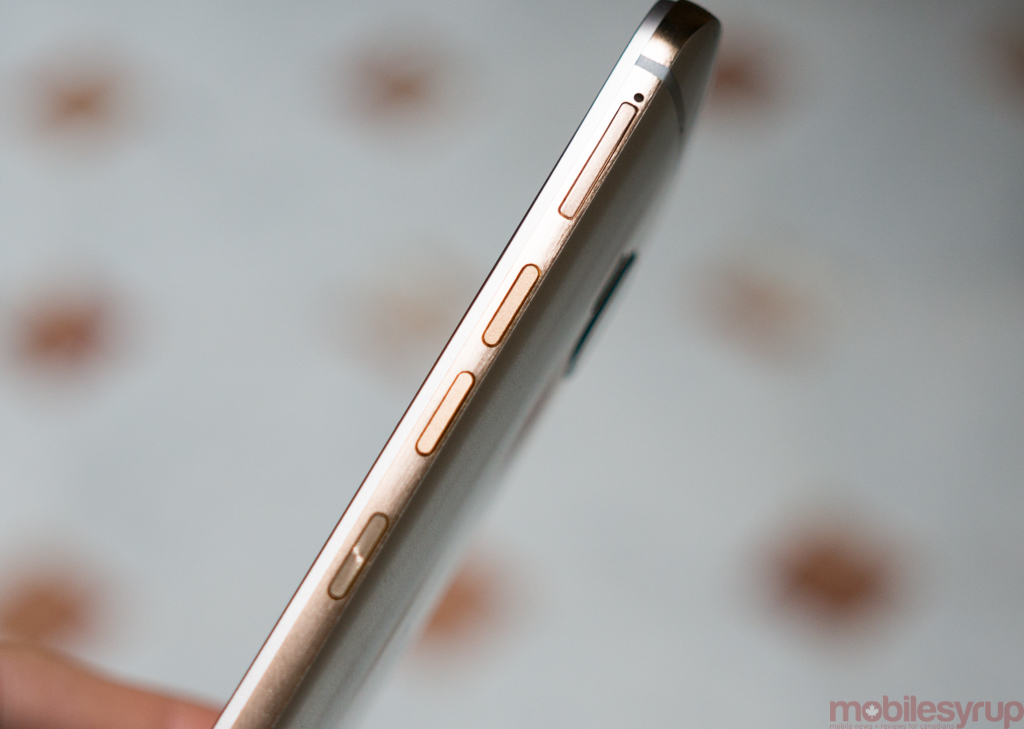
Design-wise, the biggest change to the chassis is the relocation of the power button, which now resides on the right side, halfway down the edge. What I at first thought to be a huge improvement has actually proven to be somewhat of a problem. It’s the shape; despite adding a texture to help differentiate it from the volume buttons above, the power button feels too similar when trying to remove it from one’s pocket and quickly turn it on.
Power and volume button placement may seem trivial, but these are buttons one presses hundreds of times a day. No one company appears to have it right, but Samsung and Apple’s decision to place power on the right and volume on the left feels like the best compromise. HTC has alleviated this problem somewhat by allowing users to double-tap the screen to turn it on, but I too often ended up lowering the volume on the song I was streaming than turning off the phone’s screen.
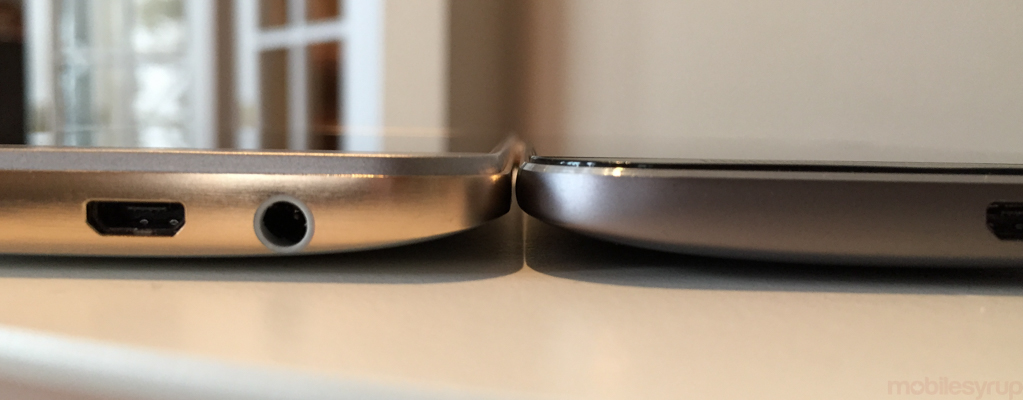
Slightly thicker than the M8 so as to hold a larger 2,840mAh battery, HTC’s newest device is ever so slightly narrower and shorter than its predecessor, resulting in a phone easier to hold. The outside edge appears to be nestled into the base, a productive optical illusion that doubles as a grip to counteract the slipperiness of the back. In doing so, HTC has addressed one of the most effusive criticisms of the One M8, which felt as if it were carved from a piece of soapstone and rubbed with baby oil.
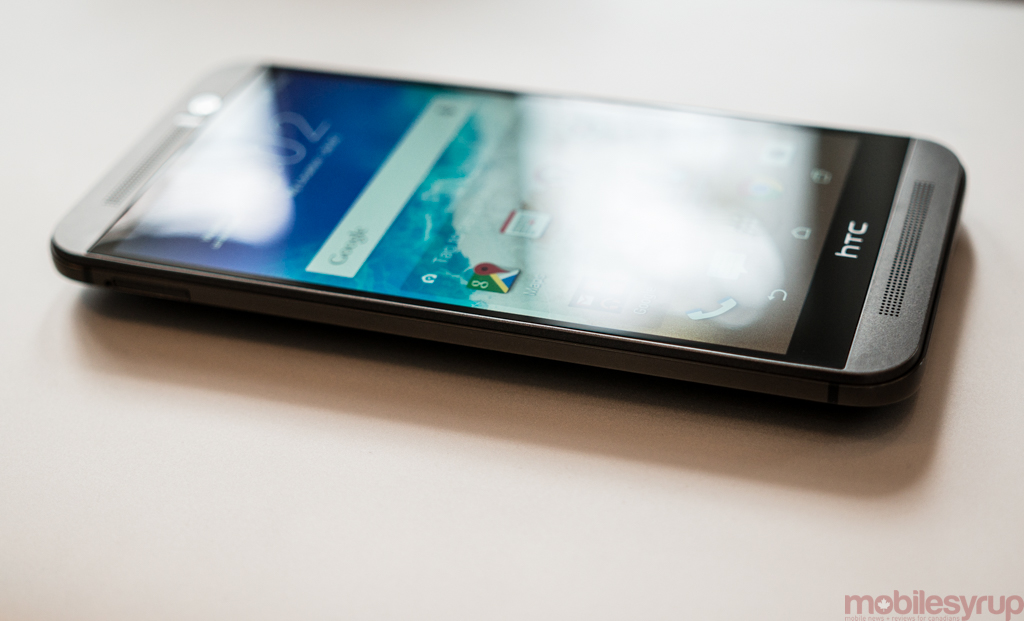
Still present on the M9 are the front-facing BoomSound stereo speakers, which continue to provide some of the best sound from a mobile device, and a beautiful 1080p Super LCD display. This year’s panel has colour accuracy improvements and higher overall brightness, which is good, but one has to squint fairly hard to see the differences.
In 2013, the One M7 had one of the best displays in the business; in 2015, despite improvements, the M9 is just one of many devices with a high-density panel. I have to commend HTC from sticking to its guns and resisting the urge to throw a larger QHD panel on here, as battery life would surely have suffered.
The panel, which still derives a pixel density of 440ppi, likely contributes to the excellent battery life I experienced. Combined with Android 5.0.2 and a relatively efficient Qualcomm Snapdragon 810 chip, the One M9 impressed with its uptime, surpassing the Samsung Galaxy S6 and Nexus 6 (on 5.0.1 — I haven’t tested Google’s flagship on Android 5.1), coming in only barely below the Galaxy Note 4 in uptime.
Qualcomm’s Snapdragon 810 chip has been scrutinized ever since Samsung announced it was jettisoning the company’s newest chip, an octa-core 64-bit option, in favour of its own Exynos 7 solution, citing thermal inefficiency. In short, the Snapdragon 810 was supposed to overheat.
In the past, an overheating CPU often meant instability, reboots and general unpleasantness; in the mobile age, it means an uncomfortable pocket or an inadvertent handwarmer. In the days leading up to this review, HTC released a software update meant to address some of the very public concerns early users had with the One M9’s combination of metal and Snapdragon. While I never experienced the same egg-frying temperatures of some of my peers, the One M9 got hot, at times uncomfortably so — but only after downloading a bunch of app updates or running benchmarks. While “reviewing” the phone, not when using it.

The update to build 1.32.401.214 affected the behaviour of the phone’s eight CPU cores, lowering the speeds at which they run under heavy load, with a higher sensitivity to thermal output. The results were stark: much lower heat output when “reviewing” the phone, and an effortlessly cool device when using it. The effect on benchmarks was clear, too, with a 5-10% reduction in scores on nearly every test.
What does this mean for the Snapdragon 810 itself? Perhaps it was rushed to market, with not enough testing in metal devices like the One M9 beforehand. But in everyday use, the phone is still significantly faster, both objectively, through benchmarks, and subjectively, after spending dozens of hours with it, than the One M8. If all of the phone’s reviewers had decided to not mention anything about the reduction in heat and benchmark scores, consumers — you, potential buyer — would be none the wiser.
It’s immediately apparent that HTC is leveraging its manufacturing and design expertise to overcome its limited component buying power. Often considered the iPhone of the Android world, HTC’s devices hold up better over time, both from a performance and reseller perspective, than many of its competitors, and the One M9’s resemblance to its predecessors is both a blessing and a curse. Its biggest change is also its biggest liability.
The M9 shifts the M8’s 4MP UltraPixel camera sensor to the front, replacing it with a more rudimentary 20.7MP shooter, which puts the phone more in line with what we’ve come to expect from other expensive smartphones. While it’s certainly easier to sell a flagship handset with claims of a high-resolution camera, HTC has alienated a lot of its core user base by abandoning the UltraPixel branding.
The idea behind UltraPixel — bigger sensors with fewer pixels — is as valid today as it was in 2013, when it debuted. Coupled with a sharp, fast lens, the UltraPixel camera let in considerably more light than any smartphone in the same size category. By moving to a 20MP sensor, the individual pixels are inevitably going to be smaller, letting in less light.
There are tradeoffs and compromises to any smartphone camera strategy, but the fact that HTC decided to go with an off-the-shelf Toshiba solution has damaged the One M9’s prospects of being a great overall smartphone. Other than sheer resolution, which is now ample, there is nothing about the camera’s photos that stood out to us. In fact, the problem with the HTC One M9’s photos are almost exactly the same as that of the Sony Xperia lineup — they’re good, but nothing more.
We tested a unit with final shipping software, and compared to some of the photos we took on preproduction builds back in late February, the quality has come a long way. White balance and auto exposure in particular have been smoothed out, and the autofocus speed is as good as ever, but when compared to photos from the Samsung Galaxy S6 or iPhone 6, details are muddy, photos are underexposed, and colours are flat.
Looking at the sample photos, you’ll notice a hefty amount of grain in dimly-lit shots, while daylight photos tend to have limited dynamic range. But not all is bad news.
Users frustrated with the One M8’s lack of spatial resolution, especially in daylight shots, will find a lot to like here. The shutter is near-instant, and though the module lacks optical image stabilization, I rarely emerged with a blurry shot.
Many of the M9’s biggest issues, too, can be corrected, either by using the excellent manual shooting mode, or by loading up a photo-editing app after the fact.
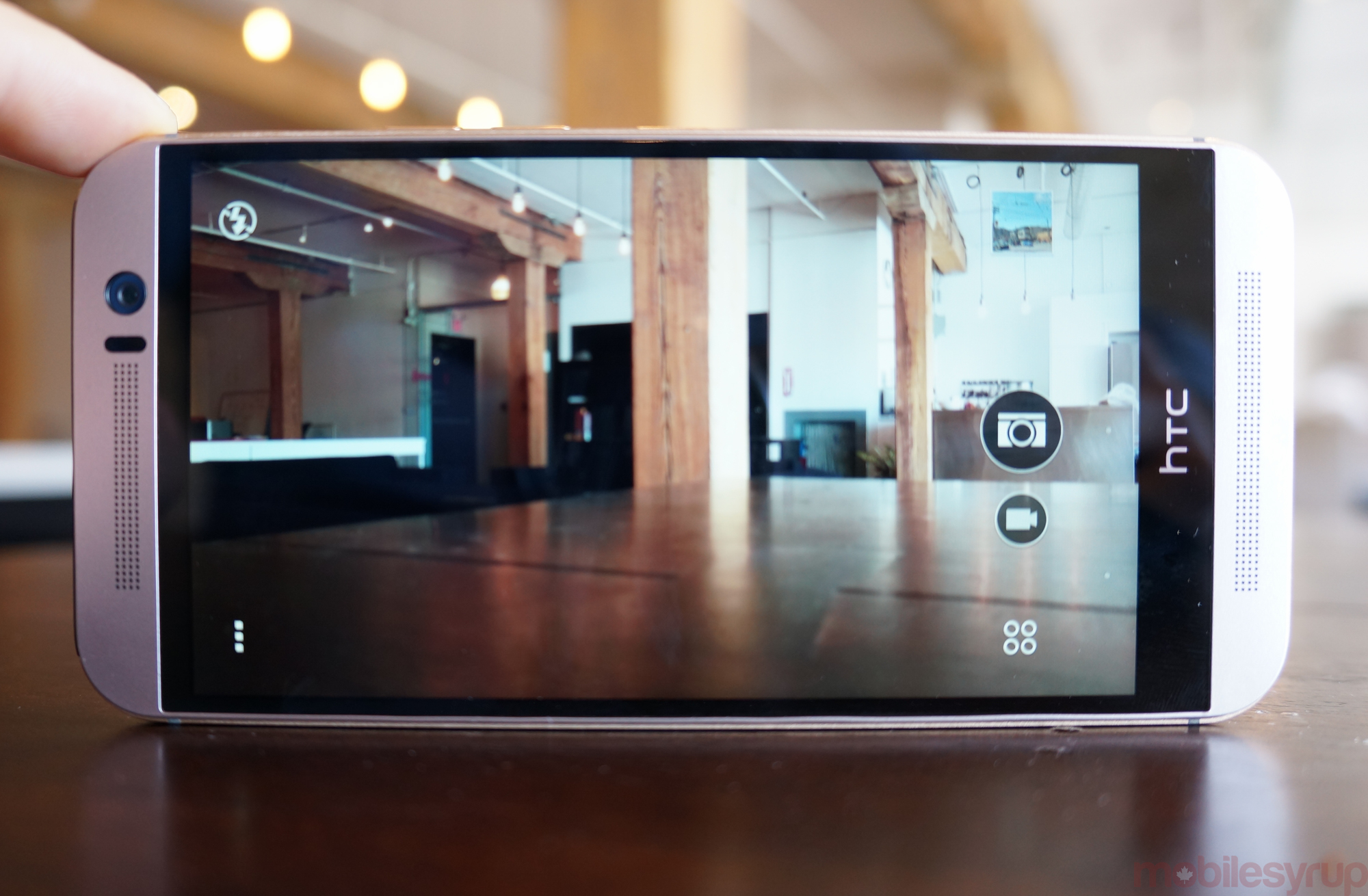
Where HTC still has an edge when it comes to camera is in its granular controls, so manual tweakers have all the necessary tools at their disposal to turn mediocre shots into great ones. HTC’s also included a few camera mode like Split Capture and Photo Booth, which debuted on the Desire EYE, as well as a new one called Bokeh that attempts to use software to recreate the depth-manipulation magic of the M8.
Recall that one of the M8’s standout features was its Duo Camera setup, which added a second 4MP camera sensor for real-time depth analysis; one could change the perspective of a photo after the fact because two photos, with different focus data, were captured and combined into one. The problem was that HTC used the Duo Camera to justify the removal of its optical image stabilization module, which helped the One M7 achieve such great low-light results, and found itself justifying its existence after Google and others introduced a software-based solution that recreated the effect nearly as well.
The M9 can, and does, take some great photos, but it’s not quite at the point where I can point at a subject on Auto mode and reliably obtain a great result. The excellent Manual mode helps, bringing shutter speed, ISO, white balance and exposure just a slider away, but I kept returning to the fact that the sensor was a limiting factor.
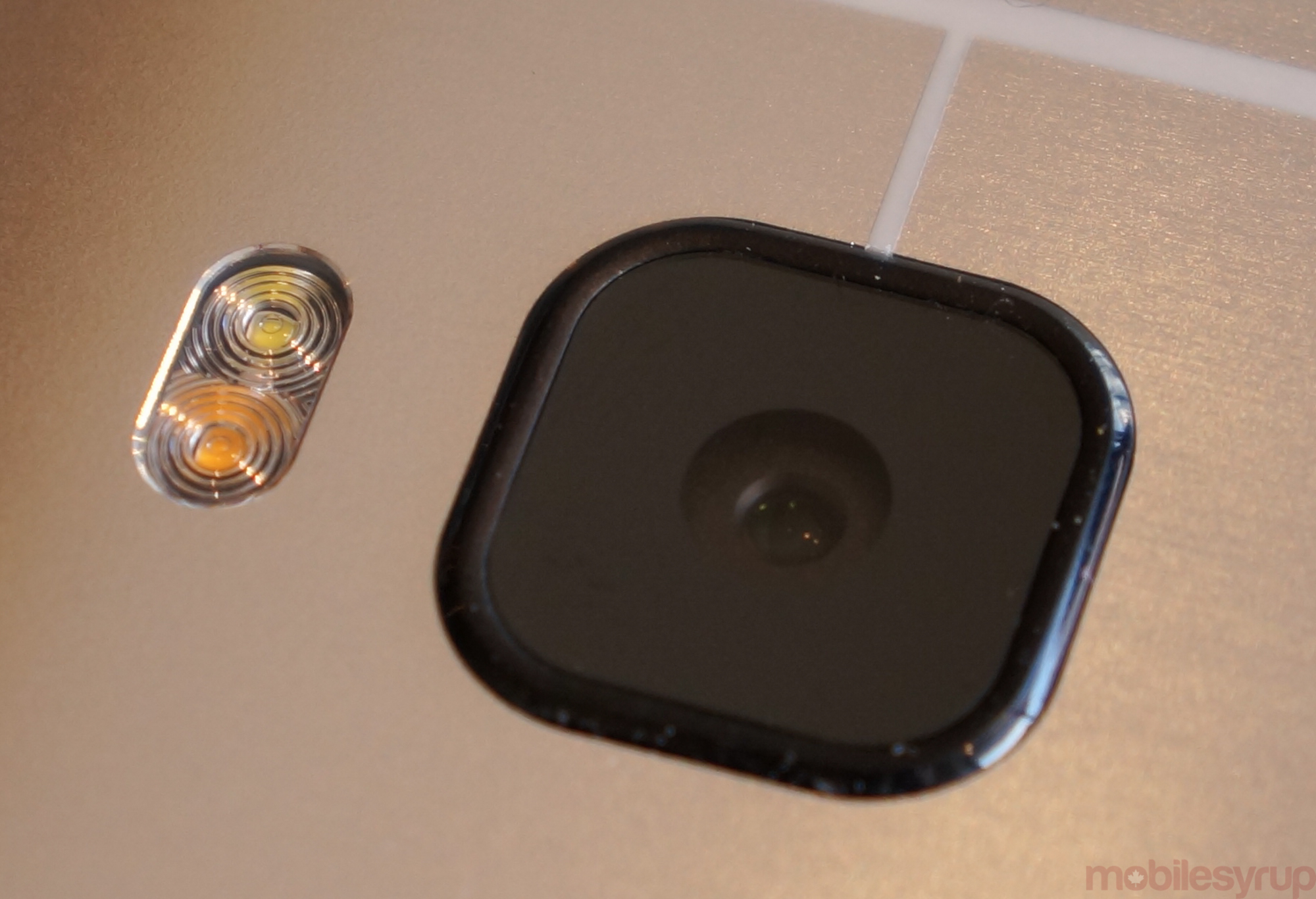
The F2.2 lens is also a considerable regression from the M8, which boasted superior light capture with its F2.0 offering. It’s unclear why HTC made the decision to divert so extremely from its UltraPixel strategy but the One M9 is not the saviour that the company so badly needed.
With the 4MP sensor now up front, users of the selfie cam have a lot to be happy about. Despite a smaller lens, the same great low-light qualities are available on one side of the device, where HTC posits most people need it. I disagree — I rarely use the FFC on my devices, so the loss is significant.
Videographers will be delighted to know that the 20MP shooter allows the One M9 to capture 4K UHD video which, along with industry-leading stereo microphones, boosts the device’s overall multimedia prowess. Indeed, even plain audio captured on the device is about as crisp as you’ll find on a non-dedicated recorder.
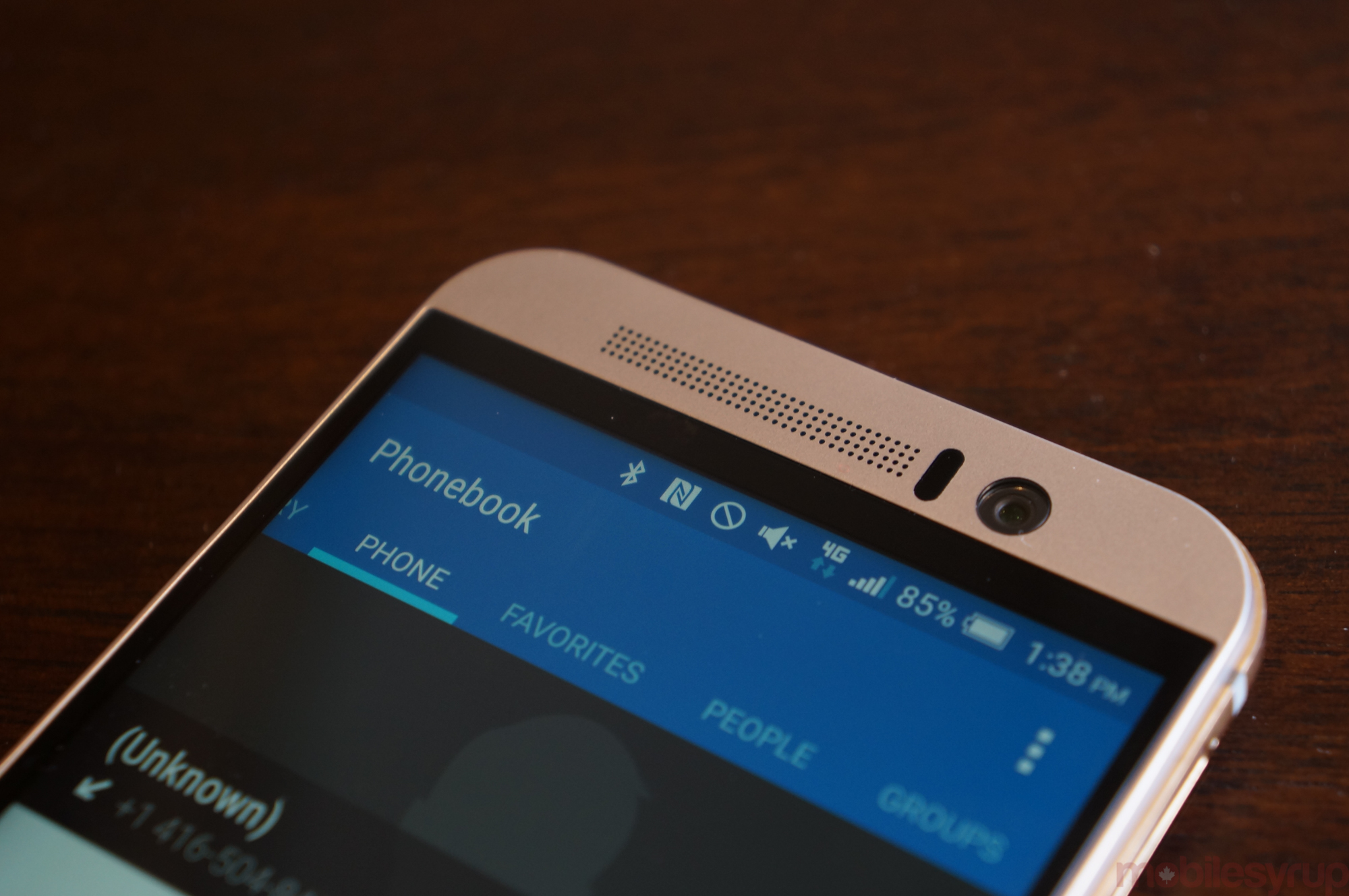
On the software side, Sense 7 feels like a natural progression of the company’s previous versions. Aside from the Theme Engine, which I covered extensively in our preview and haven’t touched since, the software is fast, fluid and in many ways beautiful.
As of today, many of my older devices, from the Moto X to the LG G3, have been updated to Lollipop, and it’s interesting to see what OEMs are changing and what they’re leaving be. HTC Sense looks like it has for the past few years, which is generally a good thing. Lighter and faster than before, it feels mature and consistent, but boring in a way a well-worn pair of shoes just slide on and are forgotten.
The way one interacts with Sense is a pretty effective microcosm for the One M9 as a whole: straightforward and free of gimmick, it focuses on getting users the information they need as quickly as possible. Indeed, Sense continues to be the only OEM skin on which I don’t immediately change the launcher.
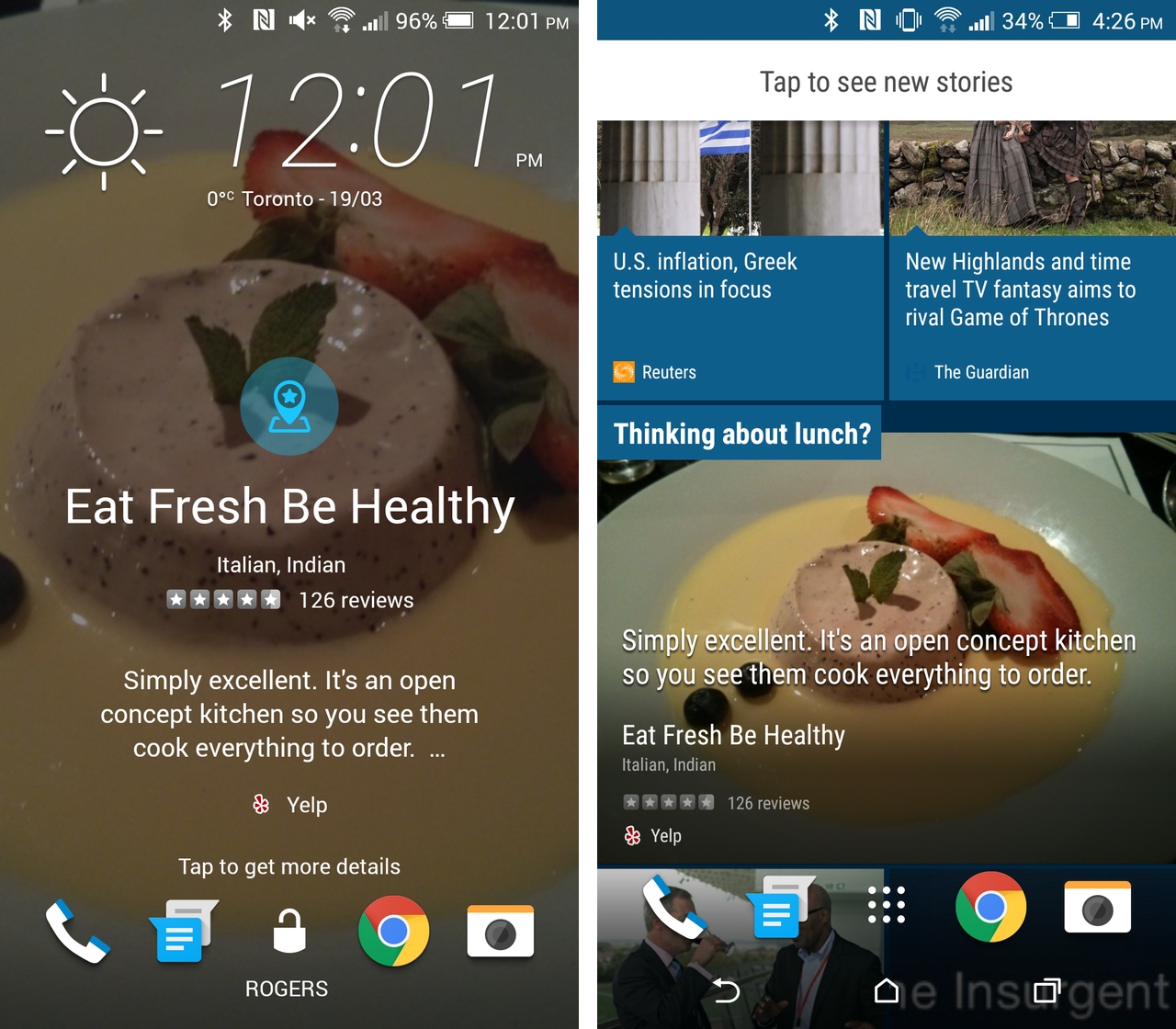
BlinkFeed, the lynchpin in HTC’s plans to begin monetizing a feed similar to Facebook, is back this year, with a Material Design brush-up and integration with Yelp. HTC’s focus on curated experiences and context identifies location — and specifically location as related to food — as an area to innovate.
Beginning with the lock screen, which thanks to Android 5’s more robust notification system has become a new screen on which to focus — BlinkFeed occasionally suggests restaurants nearby. Some of the suggestions are useless (some were closed during the suggested times or out of business) but many were relevant.
Maybe the way I consume news these days has changed since BlinkFeed debuted in 2013 but HTC’s algorithm does a good job showing interesting snippets of news and social updates at the right times. Like Google Now, which also lives on the left-most pane of its home-grown launcher, BlinkFeed sits there, out of the way but always within reach, occasionally negating the need to open Twitter, Facebook or Instagram — a palate cleanser between courses.
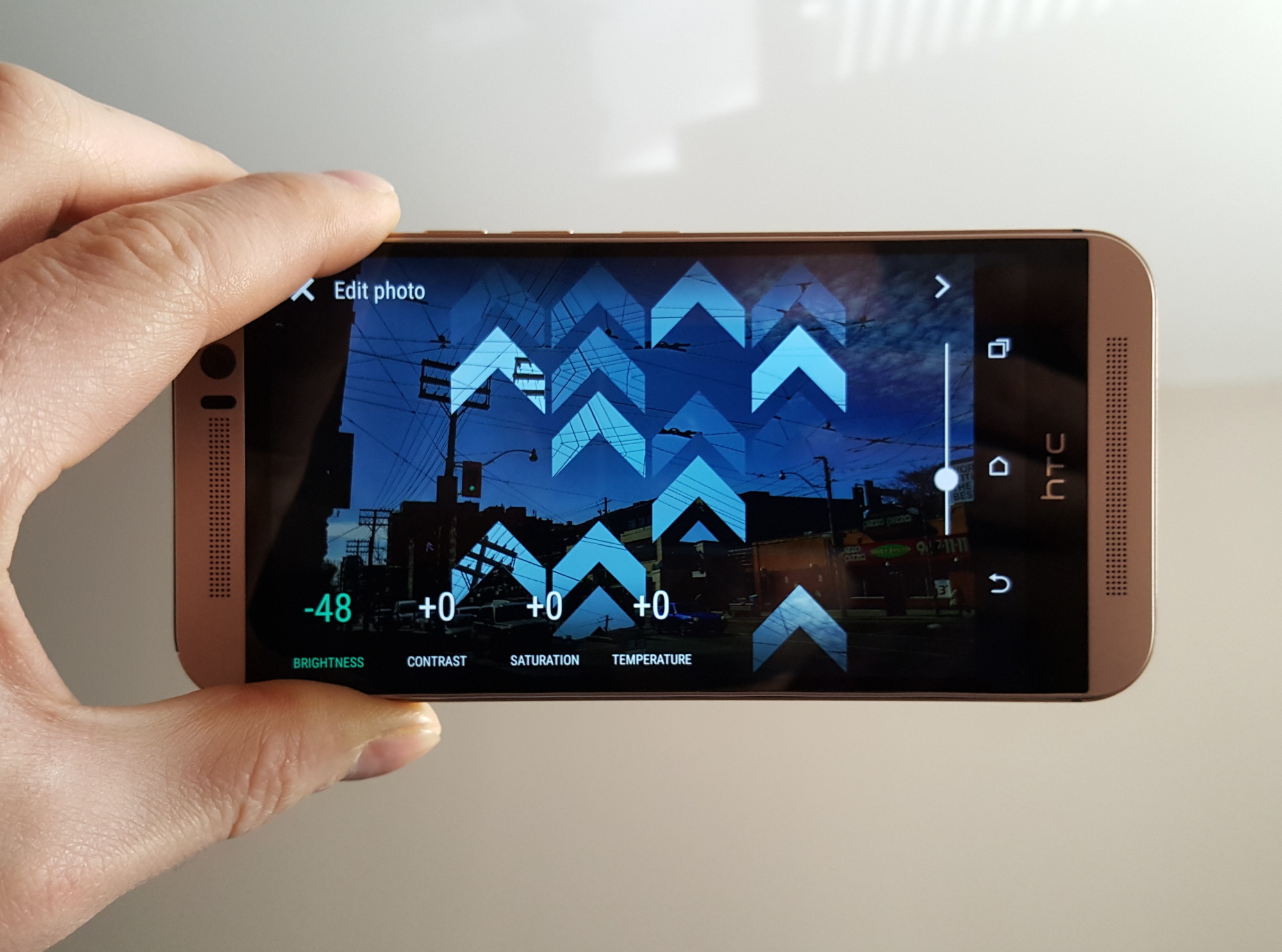
Another area in which the Sense experience has improved is in the Photo Editor, connected to the phone’s Gallery app. HTC has always prided itself on letting users do as thorough an editing job on the device as possible — frames, filters and flair — and with the One M9 the company has completed the loop.
A new Effects tab offers various geometric maneuvers, from prismatic shapes to double exposure, qualities one typically finds in third-party apps.
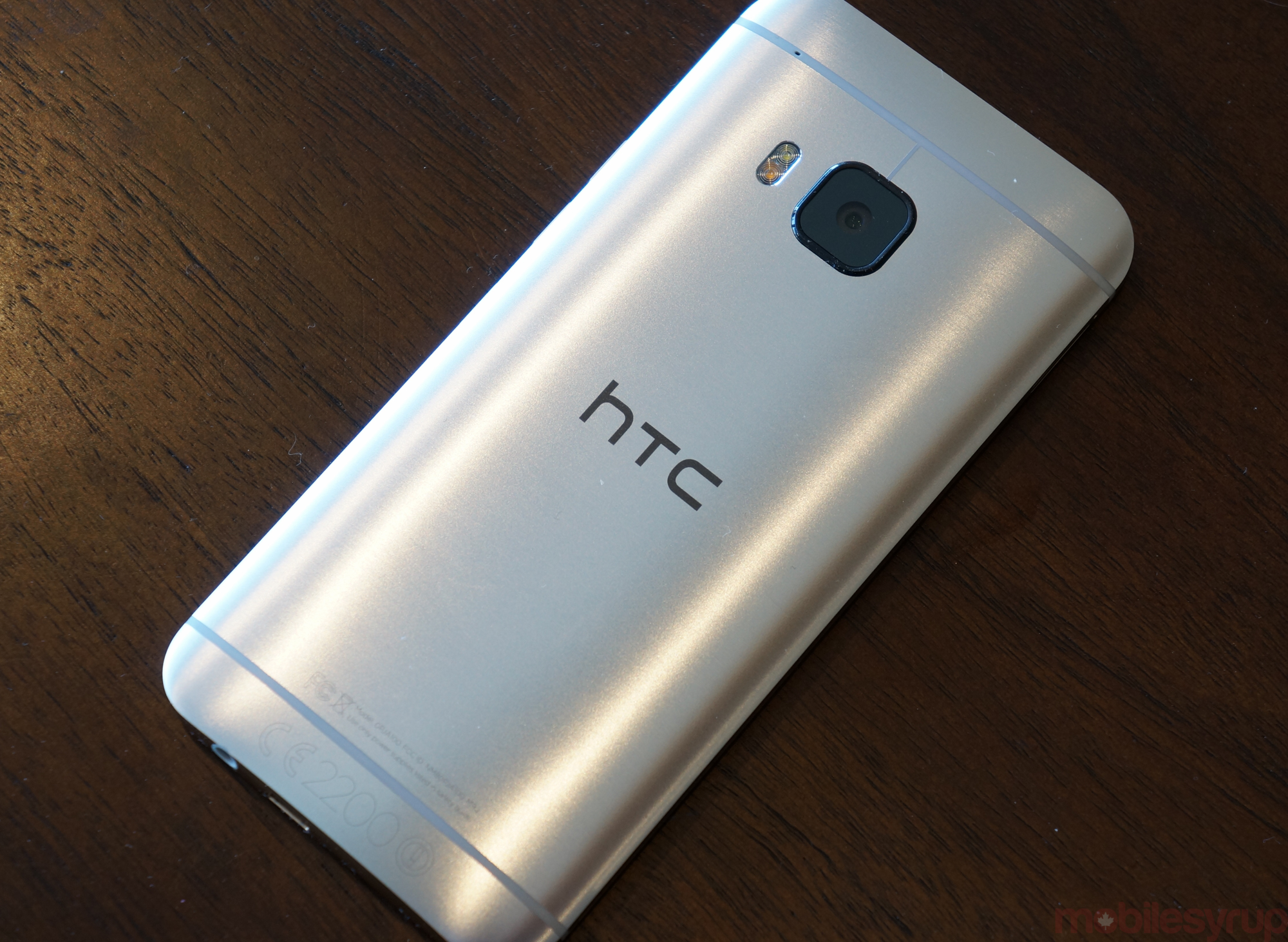
One area where the device has improved over last year’s model is battery life. The device has a 2,840mAh cell, up from 2,600mAh in the M8. Combined with the relative efficiency of Lollipop, I had no problem getting through a full day of heavy usage.
(I’m hesitant to expand on battery testing because the unit I tested lacked the correct LTE bands for Canada, and was only able to achieve 4G LTE speeds on Rogers and Bell using Band 7 2600Mhz. I’ll update this portion with a full suite of battery tests when I receive the Canadian SKU.)
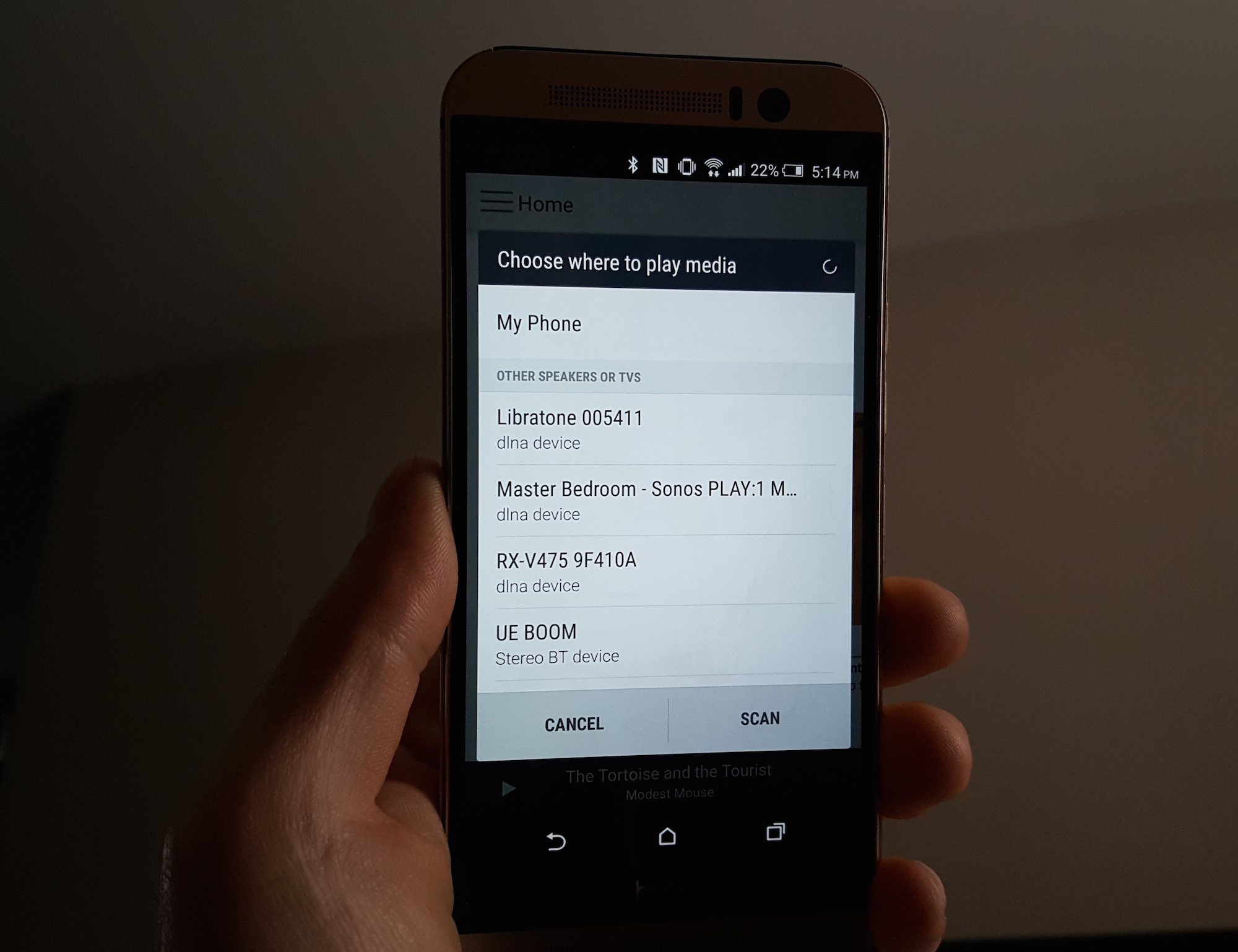
Finally, a favourite feature of the One line doesn’t get championed enough: HTC Connect. The company works with third-party audio and video standards like Qualcomm’s AllPlay, as well as BlackFire, Miracast, Bluetooth and DLNA-compatible products to stream media simply without setup. Outside of Apple’s AirPlay ecosystem, HTC’s solution continues to be the best way to connect to a multitude of wireless receivers; it’s the only Android phone in my house to work with Libratone’s suite of wireless speakers, for example.
Ultimately, the HTC One M9 relies on the core competencies that make up a good smartphone today. It has a great screen, superb build quality, a decent camera, excellent battery life and a solid future — the company continues updating its older devices, though this week we found out that the M7 won’t be upgraded past Android 5.1.
The M9 builds on the excellent qualities of the M7 and M8, design and performance chief among them, and expands them into what is one of the most solid smartphone experiences available today. It lacks the flashy components of several of its competitors — waterproofing or a fingerprint sensor — but strategic partnerships, and a strong emphasis on fundamentals, build caché in other ways.
The HTC One M9 is coming to Canada in April.
MobileSyrup may earn a commission from purchases made via our links, which helps fund the journalism we provide free on our website. These links do not influence our editorial content. Support us here.

